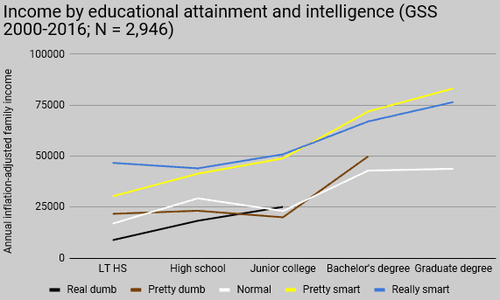Over the last several decades, educational creep has predictably led to a decrease in the average intelligence of college graduates. Yet even after controlling for intelligence, higher educational attainment is associated with higher earnings. The following graph shows mean annual earnings by highest degree attained among five tiers of intelligence as measured by Wordsum. To avoid racial confounding only non-Hispanic whites are considered. For contemporary relevance all responses are from 2000 onward. To target those in their prime working years results are for those between the ages of 35 and 60. For Wordsum utility those born outside the US are excluded:
![http://www.unz.com/uploads-old/2019/02/incomeiq.png]()
College completion signals more than intelligence. Most notably it also indicates some level of conscientiousness. And in the case of professional degrees, particularly those regulated by industry certification (law, medicine, accounting, etc), the financial benefits of a degree are obvious.
Even though higher education as it currently exists is disastrous for society as a whole, reforming it is difficult because those who have attended tend to do better than those who have not. This tends to be the case with all conventionally agreed upon public goods, regardless of whether or not those things can stand much rigorous scrutiny. While the current individual tax burden may be “too high”, those who file their taxes tend to be better off than those who do not so paradigmatic changes rarely happen.
When college becomes financially ruinous at the individual level, change will come. With the continually increasing outstanding student loan debt and the aforementioned educational creep, that must be inevitable. But we’re not there yet. Relative to a generation ago, in fact, the earnings gap by educational attainment among people of similar intelligence has widened rather than narrowed. The same parameters* but covering the years 1972-1989:
![http://www.unz.com/uploads-old/2019/02/iqeduc1972.png]()
* The HISPANIC variable was introduced in 2000, so these earlier results are restricted to those who racially identified as “white” rather than “black” or “other”, while the 2000-2016 results are for those who racially identified as white and specifically also identified as non-Hispanic. Prior to the end of the eighties, though, the country’s Hispanic population was modest anyway.
GSS variables used: RACE(1), RACECEN1(1), HISPANIC(1), AGE(35-60), REALINC, WORDSUM(0-3)(4-5)(6)(7-8)(9-10), DEGREE, BORN(1)
[Comment at Unz.com]















